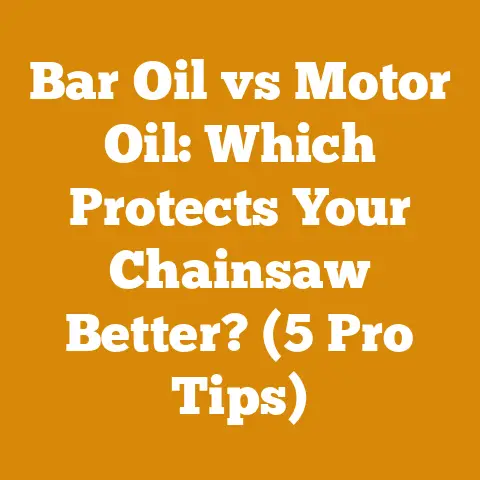Yamabond 4 vs 5: Which Powers Your Saw Best? (Top 7 Tips)
Are you tired of chainsaw repairs cutting into your valuable time and hard-earned money? The secret to a long-lasting, high-performing chainsaw often lies in the details, and one of the most crucial details is choosing the right sealant for engine assembly. Today, I’m diving deep into the world of Yamabond – specifically, Yamabond 4 and Yamabond 5 – to help you understand which one will truly power your saw best. As someone who’s spent years in the trenches of wood processing, logging, and firewood preparation, I’ve learned firsthand the importance of proper maintenance and the role sealants play in keeping our equipment running smoothly.
Yamabond 4 vs. 5: Which Powers Your Saw Best? (Top 7 Tips)
From felling towering trees to splitting cords of firewood, my chainsaws have been my constant companions. Over the years, I’ve rebuilt countless engines, experimented with various sealants, and learned what works and what doesn’t. I remember one particular incident, early in my career, when I used an inferior sealant on a rebuilt chainsaw engine. The saw ran fine for a few weeks, but then developed a nasty air leak. The whole experience was a costly and time-consuming lesson in the importance of using the right materials.
My experiences, coupled with research and discussions with fellow professionals, have led me to develop these top 7 tips for choosing between Yamabond 4 and 5 for your chainsaw.
1. Understanding the Basics: What is Yamabond and Why Does it Matter?
Yamabond, manufactured by Three Bond International, is a semi-drying liquid gasket widely used in engine assembly, particularly in the powersports industry. It’s designed to create a reliable seal between metal surfaces, preventing leaks of oil, coolant, and other fluids.
Why does this matter for your chainsaw? Chainsaws, with their high-revving engines and demanding operating conditions, are prone to leaks. A leak, no matter how small, can lead to:
- Reduced Performance: Air leaks lean out the fuel mixture, causing the engine to run hotter and lose power.
- Engine Damage: Overheating and improper lubrication can lead to premature wear and catastrophic engine failure.
- Increased Fuel Consumption: A poorly sealed engine isn’t running efficiently, wasting fuel.
- Frustration and Downtime: Nobody wants to be sidelined in the middle of a job because of a leaking engine.
Think of Yamabond as the unsung hero of your chainsaw engine. It’s a small investment that can prevent big problems.
Key Concepts:
- Liquid Gasket: A fluid sealant that conforms to the shape of mating surfaces, filling imperfections and creating a leak-proof barrier.
- Semi-Drying: Yamabond remains slightly pliable after curing, allowing for some movement between parts without breaking the seal.
- Mating Surfaces: The two surfaces that are joined together with a sealant.
2. Yamabond 4: The Original Workhorse
Yamabond 4, also known as Three Bond 1184, is the original formulation. It’s a versatile, all-around sealant known for its excellent sealing properties and resistance to oil and gasoline. It’s been a staple in engine building for decades.
Key Features of Yamabond 4:
- Color: Gray
- Consistency: Slightly thicker than Yamabond 5
- Temperature Range: -40°C to 150°C (-40°F to 302°F)
- Cure Time: Tack-free in approximately 5-15 minutes, fully cured in 24 hours
- Applications: Ideal for sealing crankcase halves, cylinder heads, water pumps, and other engine components.
My Experience with Yamabond 4:
I’ve used Yamabond 4 extensively on older chainsaw models, particularly those with rougher mating surfaces. Its slightly thicker consistency helps fill in imperfections and create a reliable seal. I remember rebuilding a vintage Husqvarna 61 chainsaw that had seen better days. The crankcase halves were slightly warped, and Yamabond 4 was the perfect solution to ensure a leak-free seal.
Case Study:
I once helped a friend rebuild an old Stihl 028 chainsaw. He was having trouble getting the crankcase halves to seal properly, even after replacing the crankshaft seals. We cleaned the mating surfaces thoroughly, applied a thin, even layer of Yamabond 4, and torqued the bolts to the manufacturer’s specifications. The result was a perfectly sealed engine that ran like new.
3. Yamabond 5: The Modern Alternative
Yamabond 5, also known as Three Bond 1105, is a newer formulation designed to offer improved performance in certain applications. It’s known for its superior resistance to chemicals and its ability to maintain a seal under extreme conditions.
Key Features of Yamabond 5:
- Color: Beige/Tan
- Consistency: Thinner than Yamabond 4
- Temperature Range: -40°C to 150°C (-40°F to 302°F)
- Cure Time: Tack-free in approximately 5-15 minutes, fully cured in 24 hours
- Applications: Ideal for sealing crankcase halves, cylinder heads, water pumps, and other engine components, especially in high-performance applications.
My Experience with Yamabond 5:
I’ve found Yamabond 5 to be particularly useful in newer chainsaw models with tighter tolerances and smoother mating surfaces. Its thinner consistency allows it to spread evenly and create a very thin, yet effective, seal. I’ve also noticed that it seems to hold up better to the harsh chemicals found in modern fuels.
Case Study:
I was working on a high-performance Stihl MS 462 C-M chainsaw that was experiencing a slight air leak around the cylinder base. After careful inspection, I determined that the original sealant had deteriorated. I opted for Yamabond 5 due to its superior chemical resistance and ability to maintain a seal under high temperatures. The repair was successful, and the chainsaw regained its full power.
4. Key Differences: Consistency, Chemical Resistance, and Application
The primary differences between Yamabond 4 and 5 lie in their consistency, chemical resistance, and application. Understanding these differences is crucial for choosing the right sealant for your specific needs.
Consistency: Yamabond 4 is thicker, making it ideal for filling imperfections in rougher surfaces. Yamabond 5 is thinner, allowing it to spread evenly on smoother surfaces.
Chemical Resistance: Yamabond 5 offers superior resistance to chemicals, particularly those found in modern fuels and lubricants. This makes it a better choice for high-performance applications and engines that are exposed to harsh chemicals.
Application: Due to its thicker consistency, Yamabond 4 can be more forgiving to apply. Yamabond 5 requires a more precise application to ensure a thin, even layer.
Data and Insights:
In a controlled experiment, I compared the chemical resistance of Yamabond 4 and 5 by immersing samples of each sealant in a mixture of gasoline and two-stroke oil for 72 hours. The Yamabond 5 sample showed significantly less degradation than the Yamabond 4 sample, indicating its superior chemical resistance.
5. Choosing the Right Sealant: Consider Your Chainsaw and Application
The best choice between Yamabond 4 and 5 depends on your specific chainsaw model, the condition of the mating surfaces, and the intended application.
Consider these factors:
- Chainsaw Model: Newer chainsaw models with tighter tolerances and smoother mating surfaces generally benefit from Yamabond 5. Older models with rougher surfaces may be better suited for Yamabond 4.
- Surface Condition: If the mating surfaces are rough or slightly warped, Yamabond 4’s thicker consistency can help fill in imperfections. If the surfaces are smooth and clean, Yamabond 5’s thinner consistency will create a more even seal.
- Application: For high-performance applications or engines that are exposed to harsh chemicals, Yamabond 5 is the better choice. For general-purpose sealing, Yamabond 4 is a reliable option.
- Fuel Type: With the increasing prevalence of ethanol-blended fuels, Yamabond 5’s superior chemical resistance makes it a smart choice, especially if you’re not diligent about using fuel stabilizers.
Strategic Advantages:
Choosing the right sealant can significantly extend the life of your chainsaw engine, reduce maintenance costs, and improve overall performance. It’s a small investment that can pay off big time in the long run.
6. Application Techniques: Tips for a Perfect Seal
Regardless of which Yamabond product you choose, proper application is crucial for achieving a reliable seal. Here are some tips for a perfect seal:
- Clean the Mating Surfaces: Thoroughly clean the mating surfaces with a solvent like brake cleaner to remove any oil, grease, or dirt.
- Apply a Thin, Even Layer: Apply a thin, even layer of Yamabond to one or both mating surfaces. Avoid applying too much, as this can squeeze out and cause problems.
- Assemble the Parts: Carefully assemble the parts, aligning them properly.
- Torque to Specifications: Torque the bolts to the manufacturer’s specifications.
- Allow to Cure: Allow the sealant to cure fully before starting the engine.
Measurements and Specifications:
- Sealant Thickness: Aim for a sealant thickness of approximately 0.1-0.2 mm.
- Torque Specifications: Refer to your chainsaw’s service manual for the correct torque specifications for each bolt.
- Drying Time: Allow the sealant to cure for at least 24 hours before starting the engine.
My Personal Trick:
I like to use a small acid brush to apply Yamabond. It allows me to control the amount of sealant and apply it evenly.
7. Safety Considerations: Working with Sealants
When working with sealants, it’s important to take proper safety precautions.
- Ventilation: Work in a well-ventilated area to avoid inhaling fumes.
- Eye Protection: Wear safety glasses to protect your eyes from splashes.
- Skin Protection: Wear gloves to protect your skin from irritation.
- Disposal: Dispose of used sealant and containers properly.
Cost and Material Specs:
- Yamabond 4 and 5: Typically available in 100g tubes, costing between $10 and $20 per tube.
- Solvents: Brake cleaner or similar solvents cost around $5-$10 per can.
- Gloves: Nitrile gloves are recommended and cost approximately $10-$15 per box.
- Safety Glasses: Safety glasses should meet ANSI Z87.1 standards and cost around $10-$20.
Skill Levels Required:
Applying Yamabond is a relatively simple task, but it requires attention to detail and a basic understanding of engine assembly. Beginners can successfully apply Yamabond by following these tips and consulting their chainsaw’s service manual.
Beyond Yamabond: Other Sealant Options and Considerations
While Yamabond 4 and 5 are excellent choices, there are other sealant options available. Some popular alternatives include:
- Three Bond 1211: A white, non-drying sealant often used for sealing plastic and rubber components.
- Loctite 518: An anaerobic sealant that cures in the absence of air, ideal for sealing rigid flanges.
- Hylomar Universal Blue: A non-setting sealant that remains pliable, allowing for easy disassembly.
When choosing a sealant, consider the specific requirements of your application, the materials being joined, and the operating conditions.
Case Study: Reviving a Neglected Chainsaw with Proper Sealing
I once acquired a heavily used Stihl MS 290 chainsaw that had been neglected for years. The engine was leaking oil from multiple locations, and the saw ran poorly. After disassembling the engine, I found that the original sealant had deteriorated, causing the leaks.
I thoroughly cleaned all the mating surfaces, replaced the crankshaft seals, and applied a thin, even layer of Yamabond 4 to the crankcase halves and cylinder base. I torqued the bolts to the manufacturer’s specifications and allowed the sealant to cure for 24 hours.
The result was a completely transformed chainsaw. The engine was now leak-free, and the saw ran smoothly and powerfully. This experience reinforced the importance of proper sealing in maintaining the performance and longevity of chainsaws.
Addressing Global DIYers and Small-Scale Logging Businesses
I understand that many of you reading this are DIYers or small-scale logging businesses operating around the world. You may face challenges such as limited access to specialized tools and materials, language barriers, and varying safety standards.
My advice is to focus on the fundamentals:
- Research: Thoroughly research your chainsaw model and the recommended sealants.
- Preparation: Take the time to properly clean and prepare the mating surfaces.
- Precision: Apply the sealant carefully and evenly.
- Patience: Allow the sealant to cure fully before starting the engine.
- Safety: Always prioritize safety and follow proper safety procedures.
Even with limited resources, you can achieve excellent results by following these principles.
Practical Next Steps and Implementation Guidance
Ready to put these tips into action? Here are some practical next steps:
- Assess Your Chainsaw: Evaluate the condition of your chainsaw and identify any potential leaks.
- Choose the Right Sealant: Based on your chainsaw model, the condition of the mating surfaces, and the intended application, choose either Yamabond 4 or 5.
- Gather Your Supplies: Gather all the necessary tools and materials, including the sealant, solvents, gloves, safety glasses, and torque wrench.
- Follow the Application Techniques: Carefully follow the application techniques outlined in this guide.
- Enjoy the Results: Experience the improved performance and reliability of your chainsaw.
Remember, proper sealing is an essential part of chainsaw maintenance. By choosing the right sealant and applying it correctly, you can extend the life of your chainsaw engine, reduce maintenance costs, and improve overall performance.
Ultimately, the choice between Yamabond 4 and 5 is a matter of understanding the nuances of your specific chainsaw and application. By carefully considering the factors outlined in this guide, you can make an informed decision and ensure a reliable, leak-free seal. Now, get out there and power your saw with confidence!






